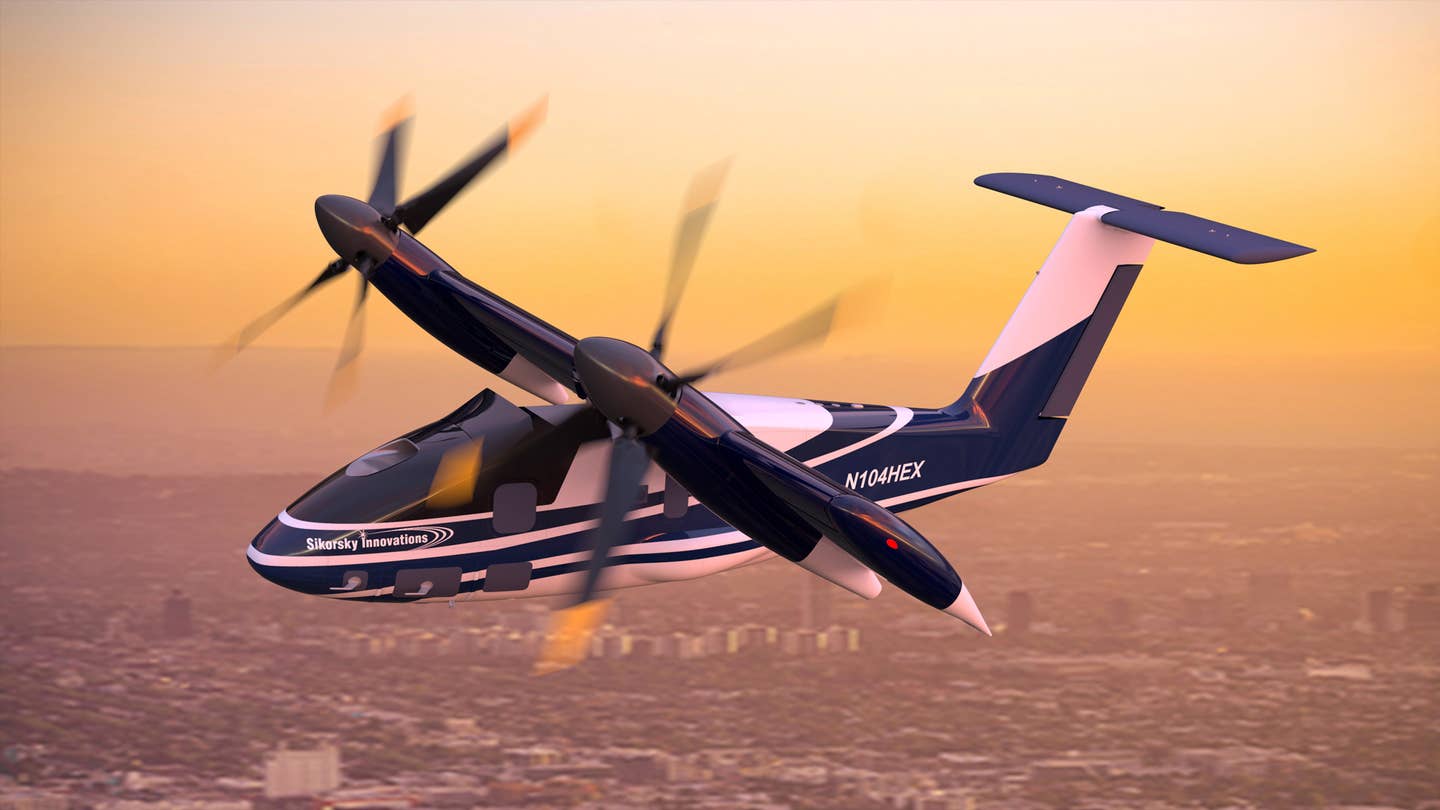Sikorsky Looks to Enter eVTOL Industry with Eye-Catching Tilt-Wing Design
The manufacturer’s HEX testbed and demonstrator aircraft will help it evaluate a future family of large, self-flying VTOL models.

A digital rendering of Sikorsky’s concept for a self-flying, tilt-wing, hybrid-electric VTOL design. [Courtesy: Sikorsky]
Sikorsky, the longtime manufacturer of rotorcraft such as the UH-60 Blackhawk and S-92 helicopter, is exploring a new family of vertical takeoff and landing (VTOL) aircraft.
The Lockheed Martin-owned firm on Tuesday unveiled its plan to build, test, and fly a fully autonomous, hybrid-electric VTOL demonstrator called HEX, which it said will be the first in a series of large, self-flying VTOL models.
Sikorsky said the HEX program is its first attempt to integrate hybrid-electric propulsion systems and advanced autonomy onto a VTOL design. The aircraft is intended to save fuel and improve performance for both commercial and military applications.
The manufacturer first hinted at a VTOL design in December 2022, announcing plans to design the HEX prototype in March. But Tuesday’s announcement revealed the aircraft will feature a unique tilt-wing architecture.
Tiltrotor or tilt-propeller designs are common in the electric vertical takeoff and landing (eVTOL) air taxi space. They involve the repositioning of those components during the transition between vertical and forward flight. Tilt-wings, by contrast, rotate the entire wing vertically during takeoff to minimize their interference on thrust.
Sikorsky also confirmed that HEX represents the inception of a family of next-generation VTOL aircraft, which was only mentioned as a possibility in March. The designs will include both rotorcraft and winged models, the company said.
The aircraft will feature different degrees of electrification, but each will be powered by the company’s Matrix autonomy system for “optionally piloted flight.” Matrix enables an aircraft to be flown by two, one, or zero pilots.
“Autonomy and electrification will bring transformational change to flight safety and operational efficiency of large VTOL aircraft,” said Paul Lemmo, president of Sikorsky. “Our HEX demonstrator program will provide valuable insights as we look to a future family of aircraft built to the scale and preferred configurations relevant to commercial and military customers.”
Sikorsky is exploring the potential for such aircraft to perform utility missions for the U.S. military or fly passengers between cities. Other manufacturers exploring eVTOL designs for air taxi services, recreational flight, or potential military use include Joby Aviation, Archer Aviation, and Pivotal.
According to Sikorsky’s website, HEX will be safer to fly and more efficient, cost effective, and sustainable to operate than conventional rotorcraft or fixed-wing designs. It said the aircraft will be capable of traveling 500 nm at high speed, lowering maintenance costs and limiting mechanical systems to reduce complexity.
Sikorsky Innovations—the company’s prototyping arm leading the HEX program—is working with partner GE Aerospace, the aircraft engine supplier subsidiary of General Electric, to finalize the design for a hybrid-electric power systems testbed aircraft, with a 600-kilowatt motor.
The testbed is the “first step,” according to the manufacturer and will be used to evaluate hover performance of the subsequent HEX demonstrator. The demonstrator will have a maximum gross weight of 9,900 pounds and a 1.2-megawatt-class turbogenerator, instead of the 1-megawatt generator proposed in March. Sikorsky in March also said that GE Aerospace would provide a CT7 turboshaft engine, though Tuesday’s announcement made no mention of it.
Over the next two to five years, the testbed and HEX demonstrator are expected to provide Sikorsky with insights into its future class of VTOL aircraft for regional and intercity travel.
“Within Sikorsky’s electric pillar, we are designing electric motors, power electronics and our own vehicle management hardware and actuation,” said Igor Cherepinsky, director of Sikorsky Innovations. “HEX will integrate these components, showcasing the growing maturity of our Matrix autonomy suite and the potential for maintenance-free systems. Seeing the results will lead us to more efficient overall designs.”
Sikorsky Innovations has developed three experimental helicopter prototypes featuring a coaxial design, with a rear propulsor in place of a tail rotor: the X2 demonstrator, S-97 Raider, and SB-1 Defiant. These models fly twice as fast as a single main rotor helicopter, with improved maneuverability and handling at low speeds, the manufacturer said.
Sikorsky has also worked with the Defense Advanced Research Projects Agency (DARPA) to demonstrate military resupply and casualty evacuation. The missions were completed using an optionally piloted UH-60A Black Hawk retrofitted with Matrix and a full-authority, fly-by-wire flight control system.
VTOL technology is a decidedly new addition to the mix, by Sikorsky’s own admission. But the manufacturer’s long history of producing rotorcraft may help it merge VTOL with its existing airframes and autonomous capabilities.
Like this story? We think you'll also like the Future of FLYING newsletter sent every Thursday afternoon. Sign up now.

Subscribe to Our Newsletter
Get the latest FLYING stories delivered directly to your inbox






